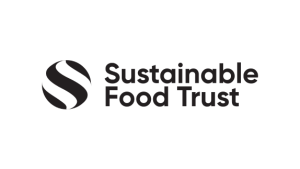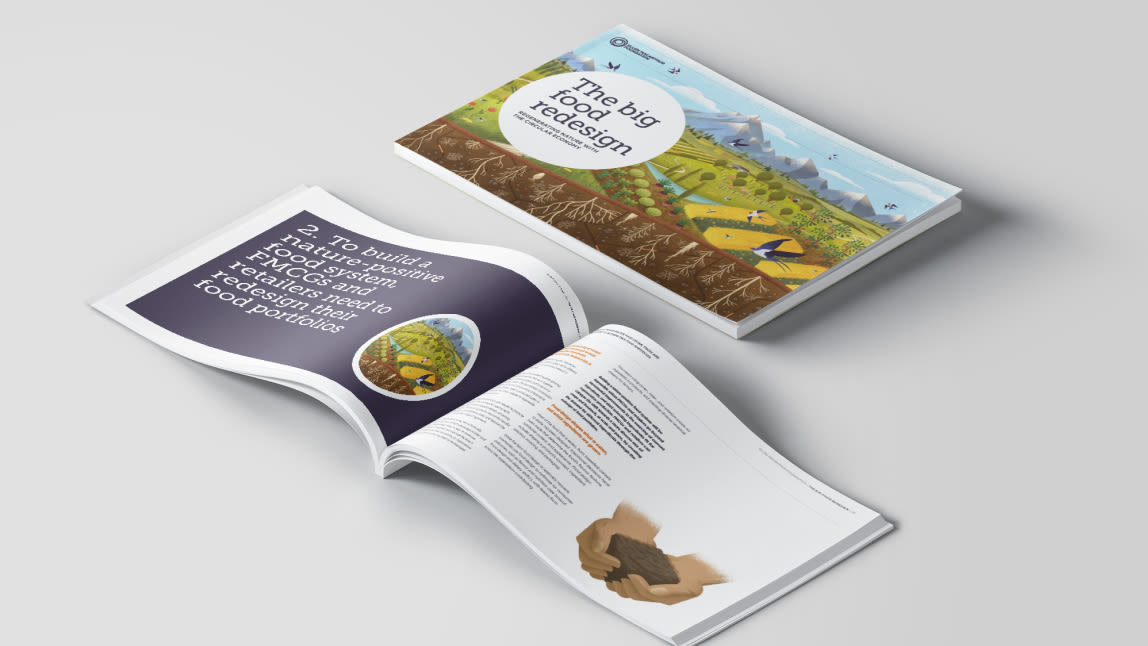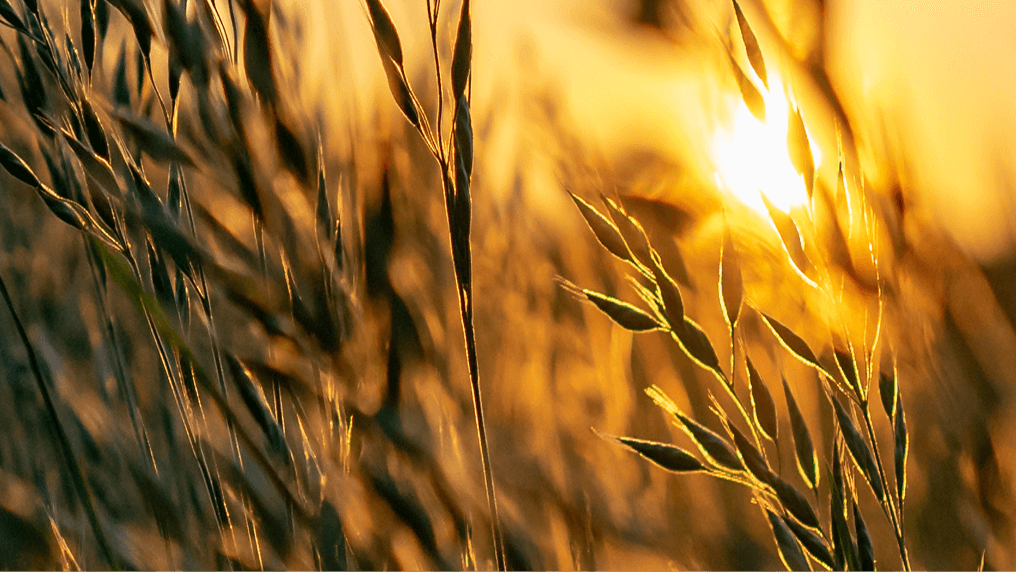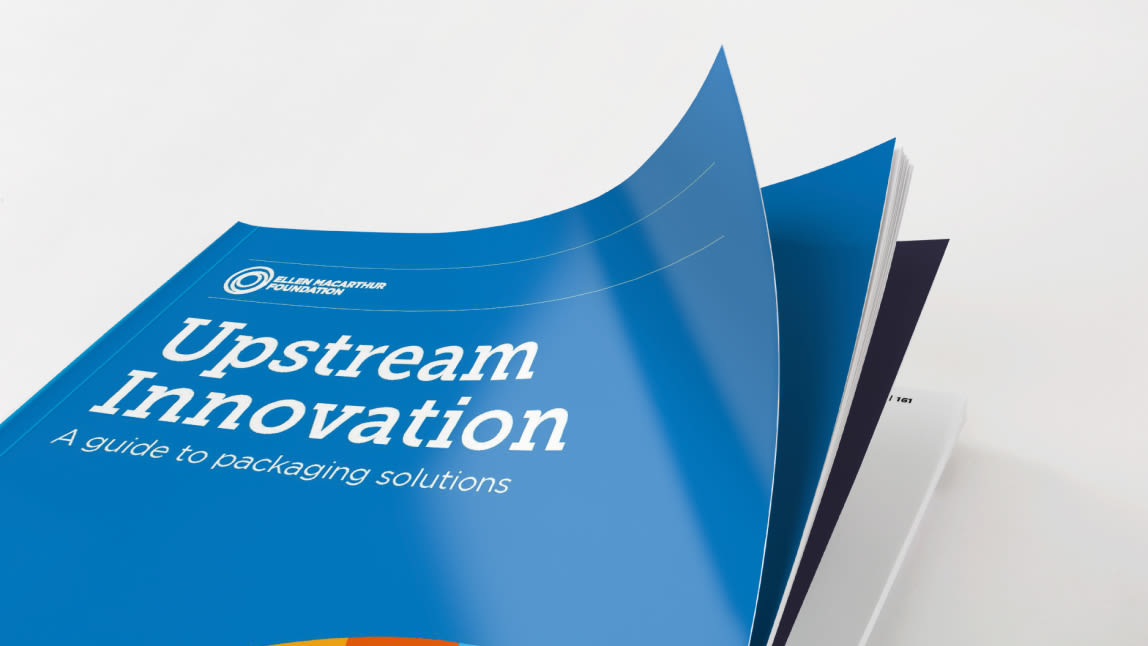Fast forward to 2030.
The food system is providing people with nutritious products, and also actively tackling climate change and building biodiversity. Food products designed to help nature thrive are at the heart of this transformation:
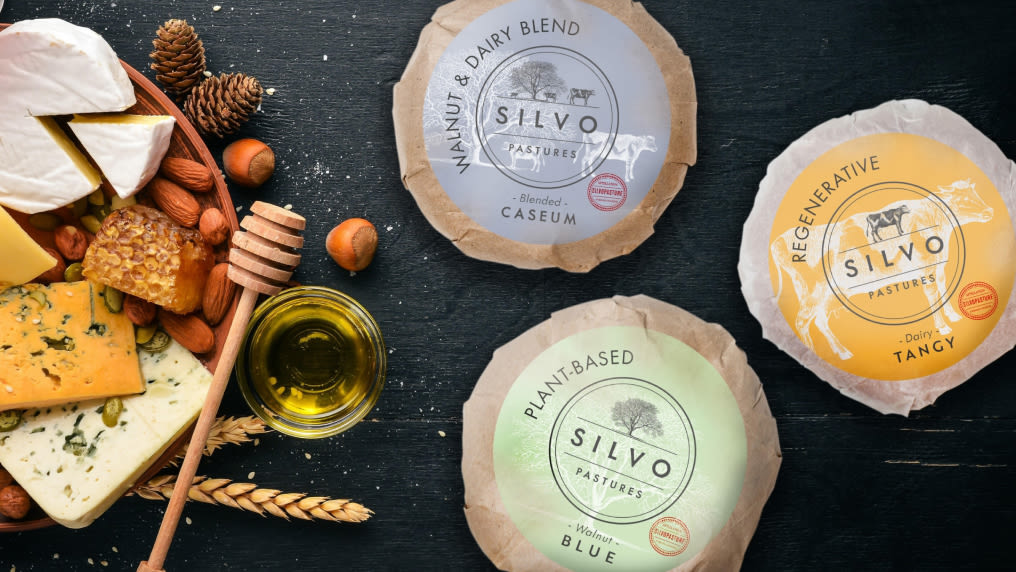
Silvo is a food brand built on the idea of facilitating better outcomes for nature. The French cheese brand works with farmers across Bretagne, in the north of the country, to make great-tasting cheeses from regeneratively produced dairy and plant-based ingredients that are good for the planet without compromise. Silvo’s award-winning cheeses are made with walnuts and cow’s milk produced together symbiotically on farms. The farmers have a more diversified income and can see the benefits to the environment of regenerative farming, while Silvo is sought-after by consumers keen for cheeses that help to regenerate nature.
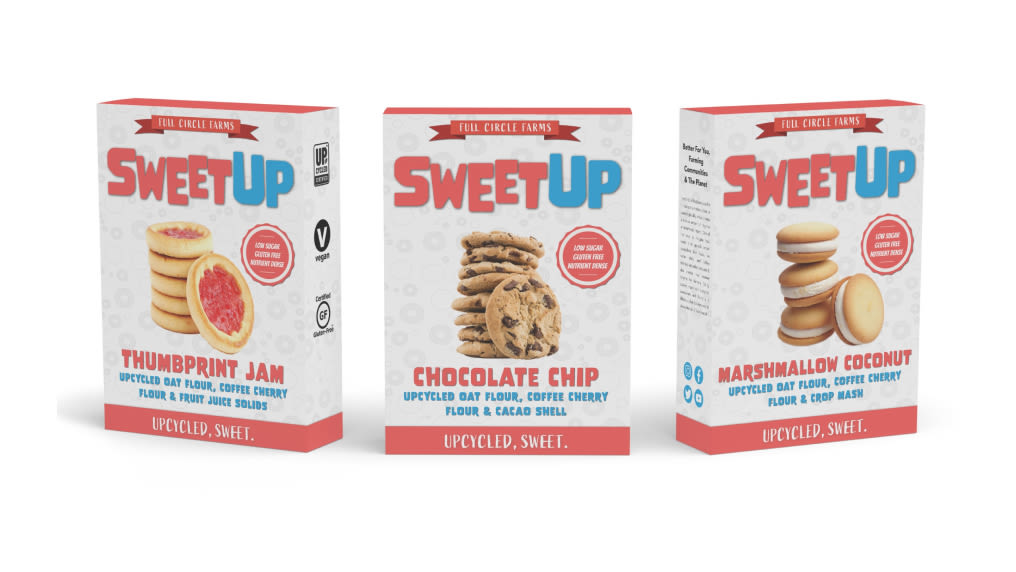
Across the English Channel, another pioneering brand is helping to heal nature. Sweet Up makes the most of nutrient-dense, upcycled ingredients by creating biscuits from blends of upcycled flours made from plant-based milk by-products and coffee cherry. The products are sweetened using ingredients that would usually be left in the field or fed to animals, including cacao fruit pulp, fruit juice pulp, and crop leftovers. Sweet Up is not only profitable, but its products are proving desirable, with the company achieving a range of major listings in leading supermarkets and hotels. Indeed, the company’s owner received a large investment from a venture capital fund because of the success of the brand.

The food system hasn’t just diversified to make better use of unusual or unused ingredients, but also to make the most of ingredients that have a lower impact on the environment. Regenerate has launched a breakfast product range called Climate Crunch, full of nutritious, protein-packed blends of wheat and peas that taste good and keep people full for hours. Peas are a great crop to use to help fix nitrogen in soil, and so all of Regenerate’s suppliers have benefitted from a healthier ecosystem at farm level and reduced the need for synthetic inputs.
These are fictional stories. But they offer a taste of how your business could create a food system in which nature and business flourish together. The choices you make over the coming months as a Big Food Redesign Challenge participant can make this vision of the future a reality.
Circular design for food offers benefits for nature, people and brands
Leading food businesses have a substantial influence on landscapes and nature. In the EU and UK, 40% of agricultural land use is influenced by the top 10 FMCGs and retailers alone. Whether you’re one of these businesses or one of those that buys the products of the other 60% of agricultural land use, organisations like yours have a huge opportunity to create a food system that is good for nature, by adopting the circular design for food framework.
It’s time to harness the collective creativity and ingenuity of your people in a new direction, joining us on our collaborative learning journey as part of the Big Food Redesign Challenge. This is a project aiming to empower brand owners to realise the opportunities offered by circular design for food in their own brand portfolios.
You can be one of the changemakers taking positive action on climate change and biodiversity.
These are enormous wins in themselves, but implementing circular design for food also offers a range of specific benefits to your stakeholders:
Consumers are actively searching shelves for products that help nature thrive and many brand owners that deliver them are seeing a return on their investment. A recent study by McKinsey discovered that products displaying ESG-related claims have recorded 28% cumulative growth over the last five years compared to 20% for products with no such claims.
Diversity works for all parts of the food ecosystem. Your business can build diversity into its supply chains, which will help guard against the effects of extreme weather, pests, and disease.
Farmers can build more resilient incomes from the produce of a regeneratively-designed food system.
Your employees will feel motivated to be contributing to a business that takes a proactive role in creating a more hopeful future.
Shareholders are starting to recognise that a business embracing nature-positive strategies is future-proofing itself, as such a transformation can help to insulate your business to shocks and anticipate any future changes to legislation.
By redesigning your products, you can regenerate landscapes
Your food portfolio is like a microcosm of the food system. The natural landscape is effectively your supplier – and is shaped by what you choose to include in your products.
Currently, these portfolios are made up of many food products that are created from only a small range of common ingredients. Only four crops (rice, wheat, potatoes, and corn) make up 60% of all global food consumption. This has resulted in landscapes of monocrops and a dwindling of the vital complexity that protects the health of soils.
Transitioning from this linear, monoculture system to one in which nature thrives means redesigning portfolios with nature in mind, and reintroducing the complexity that has been lost.
Food businesses can design diversity into the system by using more ingredient varieties, as well as sourcing lower impact and upcycled ingredients, all regeneratively produced, that enable producers to use practices, at the farm level, that help rebuild soil health and biodiversity.
Product redesign is the start of the transition. By rethinking products and the ingredients that go into them, positive changes can ultimately take place across landscapes and ecosystems.
Circular design for food combines food design with the principles of the circular economy to put nature at the heart of every design decision, and offers an actionable framework to redesign products for nature-positive outcomes.
By rethinking product concepts, ingredient selection and sourcing, and packaging, a whole host of new creative possibilities are opened up, while unlocking substantial environmental, economic, and yield benefits.
Circular design for food comprises four ingredient sourcing and selection categories:
Switching to ingredients that feed people using less land and fewer resources (lower impact)
Using ingredients from a variety of species and breeds suitable for local conditions and that create resilience (diverse)
Eliminating waste and pollution by using all of what is produced (upcycled)
Sourcing ingredients from farms that adopt practices that have regenerative outcomes for nature, like agroecology, agroforestry, and conservation agriculture (regenerative)
Analysis has already shown the exciting potential for this system - in terms of the metrics that really matter. When these design opportunities are appropriately combined, our research found that GHG emissions can be reduced by 70% and biodiversity loss can be reduced by 50%, compared with conventional production. These are the kind of substantial impacts that could make a real difference to our planet.
Research has also shown that prioritising nature doesn’t have to mean we compromise on food production. Total food output of the same land area could increase by 50%, while farmer cash flow could increase by USD 3,100 per hectare on average, following a transition period. These outcomes are significantly greater than just better sourcing of current ingredients.
But realising these kind of benefits isn’t just a case of importing the framework. The real value happens when circular food design principles are applied in a way that is sensitive to the unique ecosystems from which ingredients are sourced.
Regeneration of ecosystems requires growing and rearing diverse plants and livestock that work together symbiotically in farming systems and in harmony with surrounding nature. The appropriate combination of ingredients and production practices is tailored to the unique local context. What this means in the context of redesigning food products is for businesses to develop much more collaborative and dynamic relationships with food growers and producers.
Case Study 1: Noodles that help diversify landscapes and regenerate nature
Look at the ingredients list on any one of the 95 billion packs of packaged ramen noodles that are eaten each year around the world and top of the list you will almost certainly see wheat flour and palm oil. These two crops are often associated with intensive cultivation, which is highly carbon-emitting and degrading of nature. There is a huge opportunity to redesign products such as ramen to satisfy the rapidly growing market segment of customers keen for food products that generate more positive outcomes for the natural world.
US-based Lotus Foods is taking this approach to the sourcing and design of its rice and rice-based noodle products by substituting wheat with organic brown rice and millet flour in its popular ramen.
Lotus has incentivised its rice suppliers in Cambodia, India, Indonesia, and Thailand to diversify production to include heirloom grains such as black Forbidden Rice®, and authentic traditional varieties of jasmine, basmati and red rice, which are more suited to a particular farming region and can reduce input costs. Lotus Foods, alongside local partners such as Delhi-based PraTithi Organic Foods, is also committed to a form of regenerative rice production called the System of Rice Intensification (SRI).
This refers to the ability to generate higher yields but with less water, and without chemical fertilisers and pesticides. It uses green manures, precise planting of rice seedlings, and careful water management. The result is higher yields, 25-50% less water used, better quality of life for farmers, and carbon that is sequestered in the soil rather than released into the atmosphere. Lotus Foods’ basmati rice, grown by farmers using SRI methods, was the first rice to be Regenerative Organic Certified™ (ROC).
Rethinking ingredient selection and sourcing in this way is a great example of the potential for food brands and retailers to help address global challenges. Currently rice farming consumes between one quarter and one third of the planet’s annual renewable freshwater supplies and produces more carbon than the entire global aviation industry.
If regenerative practices like SRI increased from the current 4% to 25% of total production, this would draw down all the emissions currently produced by India, and significantly increase rice supplies, while using a lot less water and improving the lives of millions of farmers.
Case Study 2: Diversity yields resilience and great flavour
The rediscovery of a ‘forgotten’ coffee species in the forests of Sierra Leone in 2018 was exciting and important news.
“Humanity runs on coffee” sounds a bit hyperbolic, but with 2.5 billion cups served a day and over 125 million people worldwide depending on coffee for their livelihoods, the anonymous T-shirt quote does contain a bean of truth.
The new coffee species, stenophylla, could, according to Dr Aaron Davis, head of coffee research at Kew Gardens “ensure the future of high-quality coffee”.
Why is the discovery so significant? Despite the 129 coffee species identified to date, almost 100% of daily consumption comes from just two species: arabica (75%) and robusta (25%). There are good practical reasons for this, including flavour, aroma, hardiness, and yield. But as climate change sees raised temperatures, reduced rainfall, and shifts in disease patterns, this lack of diversity in the global coffee supply chain could lead to devastating consequences.
This explains some of the excitement around stenophylla, a wild-species that has a flavour and sensory profile analogous to high-quality arabica, but is cultivable in annual temperatures that are more than six degrees higher. Although still not commercially available, its discovery could broaden the climate envelope for coffee growing as well as introduce very useful cross-breeding potential that could increase both the resilience and flavour offerings of the industry.
Stenophylla is both a great illustration of the importance of increased diversity in the food system, as well as the need to safeguard the planet’s wild areas and biodiversity as repositories of future flavours and growth opportunities.
You can harness ingredients that work with nature.
Here’s a flavour of the kind of ingredients your team could leverage to make circular design for food a reality.
Lower impact: Wakame seaweed
Cultivated for centuries by sea farmers in Korea and Japan, deep-green coloured wakame is rich in nutrients and easy to grow. Maintaining similar properties to other seaweeds, it can be harvested all year round, grows rapidly without the use of fertilisers or pesticides, and supports the water’s biological balance. In addition to containing a variety of vitamins and minerals, wakame is one of the few plant-based sources of the omega 3 fatty acid EPA (eicosapentaenoic acid), which is found almost exclusively in fatty fish that feed on algae. Most commonly sold dried and then rehydrated, wakame has a savoury flavour and satin-like texture.
Lower impact: Spelt
An ancient form of wheat, spelt is a hybrid of emmer wheat and goat grass. Due to its high carbohydrate content, the Romans called it the ‘marching grain’. It has a thick outer husk that helps to protect it from disease and pests, making it easier for farmers to grow without the need for fertilisers or pesticides. Compared to similar types of wheat, it contains more fibre, as well as higher concentrations of minerals, including magnesium, iron, and zinc. Spelt is often one of the components of farro, which is a mix of various types of wheat and is becoming more popular in some parts of Europe and North America. The mellow, nutty flavour of spelt makes it a popular substitute for rice in pilaf, risotto, and side dishes.
Lower impact: Heritage rice
Adoption of heritage varieties of jasmine, basmati, and red rice – suited to specific farming regions – have been shown to generate higher yields with less water, and without chemical fertilisers and pesticides. In addition, adopting regenerative farm-level practices such as using green manures, precise planting of rice seedlings, and careful water management has been found to result in 25-50% less water used, better quality of life for farmers, and carbon that is sequestered in the soil rather than released into the atmosphere.
Diverse: Oloton maize
Oloton maize has been grown by the Mexican Mixe people for thousands of years. Cultivated high in the mountains in poor soil, this maize plant still manages to grow tall with an above-ground root system that produces a mucus. When analysed, it was found that a wide variety of bacterial groups lived within the mucus, all of which perform important functions, including the fixation of nitrogen from the atmosphere. The extraordinary potential of this very rare variety of maize is a reminder of why we need to save precious genetic resources. It also shows us how food diversity only exists because of the communities that value these vital ingredients.
Diverse: Buckwheat
Buckwheat is one of the healthiest, nuttiest, and most versatile grains. It is a short season crop, maturing in just eight to twelve weeks, and grows well in both acidic and underfertilised soils. It can also be used as a ‘cover crop’ or ‘smother crop’ to help keep weeds down and reduce soil erosion while fields rest during crop rotation. Contrary to its name, buckwheat is not related to wheat and is gluten-free. It is an ideal higher protein swap for flour in pastas and breads. It can also be a great alternative to rice, is ideal cooked in a broth or stock, and can be used in salads or stuffing.
Diverse: The Milpa System
The Milpa system is an example of how companion cropping can create a well-balanced, beneficial field system. This traditional system has been used for thousands of years in Mesoamerica to grow crops. In this system, maize is planted alongside companion crops of beans and squashes. The maize provides a structure over which the beans can grow, the beans fix nitrogen into the soil, benefitting the other plants nutritionally, while the squash’s leaves provide ground cover to stop weeds growing and to keep moisture in the soil. Not only do these plants work in harmony to grow, but together they provide a nutritionally balanced meal.
Upcycled: Beet Greens
Beets have grown in popularity in recent years and are associated with a variety of health benefits. However, the leafy green part of the beetroot is the most nutritious part of the plant and is often overlooked and left unused. With a flavour and nutrition profile similar to that of Swiss chard, beet greens are rich in vitamins K and A37. Compared to greens such as turnip and mustard greens, beet greens contain higher levels of magnesium and potassium. Per serving, beet greens provide up to 25% of the recommended daily allowance of magnesium, which helps regulate a variety of biochemical reactions in the body, including muscle and nerve function, blood pressure, and blood glucose control. Studies in the US and Europe report that around 50% of people get less than the recommended levels of magnesium. Beet greens also contain as much iron as spinach, plus the plant pigment lutein, which is associated with good eye health. Beet plants thrive in cooler temperatures, are tolerant of frost, and grow at a rapid pace. These plants are a nutrition-packed addition to stews, soups, and salads. With a subtle taste that is similar to kale, beet greens are delicious sautéed in olive oil or balsamic vinegar for a tasty side dish.
Upcycled: Coffee Cherry
Using coffee cherry as an ingredient, rather than leaving it to decompose on farms (as it typically is today), could prevent 16.6m tonnes of CO2 emissions from being produced. It also generates economic opportunities for farmers and food businesses alike. Analysis suggests that coffee farmers could increase their annual income by 20% through selling the whole fruit, which can be upcycled into sweeteners and other products, rather than just selling the coffee beans.
Upcycled: Pumpkin flowers and leaves
Pumpkin leaves and flowers are not only edible, but also highly nutritious and delicious. The combination of mild pumpkin taste and soft texture make them the perfect addition to soups, sauces, salads, and pasta dishes. Like other cucurbits, pumpkins grow best in rich, well-drained soil in the hot, humid climates of Egypt, Mexico, India, parts of the US, China, and Ukraine. It is recommended to discard the centre of the flower (the stamen) prior to preparation. The flowers are rich in many nutrients, including vitamin C. Currently, these precious flowers are often discarded, wasting a good source of nutrients and flavour.
You can be a leader in unlocking the potential of regenerative production at scale.
Underpinning the lower impact, diverse, and upcycled ingredient opportunities lies regenerative production.
Today, many conversations focus on regenerative productionregenerative productionRegenerative production provides food and materials in ways that support positive outcomes for nature, which include but are not limited to: healthy and stable soils, improved local biodiversity, improved air and water quality. of the same ingredients. But it just isn’t possible to keep producing the same things, regeneratively. To unlock regenerative production at scale, we need diversity, we need low impact ingredients that replenish natural systems, and we need to utilise all the edible parts of what we grow. In food design, the magic therefore happens when you apply regenerative production to the way lower impact, diverse, and upcycled ingredients are grown and managed.
What do we mean by regenerative production?
Ingredients should be produced in ways that lead to positive outcomes for nature which include, but are not limited to, healthy and stable soils, better local biodiversity, and improved air and water quality.
Farmers can be guided by schools of thought such as agroecology, permaculture, agroforestry, and more. The practices used on the farm will be context dependent – there is no one size fits all, and timescales to realise outcomes and economic benefits may vary greatly. A wheat farmer who uses cover-crops in their rotation may see benefits on a shorter timescale than a farmer who integrates trees into pasture (silvopasture) who may wait several years before the trees are fully grown. Both scenarios can bring benefits for current and also, importantly, future generations of farmers.
Businesses can play a role in supporting farmers who grow and manage the ingredients they need for their food products by creating closer, more meaningful, and transparent links with them. These collaborations could take the form of new buying models, new contract terms, working with cooperatives and third-party suppliers, knowledge-sharingsharingThe use of a product by multiple users. It is a practice that retains the highest value of a product by extending its use period. facilitation, and cost-sharing initiatives.
For example, Tamalu Farm in Kenya uses an agroforestry system in which trees and crops are grown on the same area of land. The farm produces portfolios of ingredients from the same area; this has made the farm’s income stream more resilient and the quality of the produce has enabled the farm to unlock higher value markets. At the same time the approach has enhanced biodiversity and built soil health.
You can adopt packaging solutions that achieve circular economy goals.
This Challenge isn’t just about redesigning the formulations of products; it’s also about how those products are presented. The Challenge will reward companies that create packaging that also minimises the impact on nature.
The base-level expectation is that packaging components should be recyclable or compostable. One of the central principles of a circular economy is that materials should keep circulating within the economy.
The ultimate goal is that packaging should move beyond the waste inherent in single-use. Ideally, Challenge entries should be delivered using a reusable format. This kind of upstream innovation may necessitate a rethink at product level, ultimately creating something that will be novel and inspiring for consumers.
Here are some packaging solutions that fit within the circular design framework:
Edible Food Packaging: Eliminating waste at the design stage
Ooho is an edible and home compostable “blob” for beverages and condiments made from seaweed. It offers an alternative to the small flexible packaging often currently used in takeaway food and beverages, which has a low recycling value and can leak into the environment, harming biodiversity. The blob can be eaten or composted and, if in the very worst-case scenario it ends up in the environment, it will take less than six weeks to biodegrade. Ooho’s potential is being recognised by various market players. Following a successful trial of Lucozade-filled Oohos at the 2019 London Marathon, Ooho is being rolled out as the selected hydration solution for Lucozade at running events. They are also partnering with Just Eat, Hellmann’s, and Innovate UK to scale the uptake of Ooho as an alternative for plastic condiment sachets throughout the UK.
Notpla, the company behind Ooho, is now exploring other applications, such as seaweed-based takeaway boxes, heat-sealable films, and sachets for non-food products. During an eight-week trial with ten London restaurants, 46,000 sauce sachets were eliminated.
Edible Food Protection: Avoiding spoilage and improving food quality
Apeel is a company that has come up with an innovative way to eliminate single-use shrink wrap plastic packaging on fresh fruit and veg, while at the same time tackling food waste. Apeel is a layer of edible, plant-based coating applied to fresh products that mimics and enhances the natural defences of fruit and vegetables. Adding the Apeel layer slows down the two main things that cause spoilage – water loss and oxidation.
Apeel makes it possible for growers to avoid harvesting before ripeness. This allows fruit and vegetables to develop to their full quality (taking into account nutrition and flavour to appearance and texture) before they begin the journey to supermarkets and supply outlets.
Fruit and vegetables treated with Apeel stay fresh two to three times longer, which promotes better quality food, and ensures less food waste for everyone.
Reusable Packaging Models
ReuseReuseThe repeated use of a product or component for its intended purpose without significant modification. models to deliver products to customers can include refill-at-home, refill-on-the-go, return-from-home, and return-on-the-go.
Algramo offers an example of a system that allows customers to refill household products on the go by using smart-powered dispensing machines and packaging chipped with RFID. Customers credit their account through an app and bring their smart packaging to an Algramo dispenser, the machine then recognises the packaging and dispenses the right product at a desired quantity without the need for login or payment.
Reuse is the gold standard for a circular economycircular economyA systems solution framework that tackles global challenges like climate change, biodiversity loss, waste, and pollution. It is based on three principles, driven by design: eliminate waste and pollution, circulate products and materials (at their highest value), and regenerate nature. for packaging because, unlike recycling, it maintains the structural integrity of the materials, thereby conserving all of the resources used in the manufacturing process.
More information and examples are available in the Ellen MacArthur Foundation's Upstream Innovation Guide.
The choices you and your team make over the coming months will not only help shape the future of food, but also create a bold new vision for your business.
Taking part in this Challenge is a landmark moment, signifying your decision to help make food designed for nature the norm.
Embark on a collaborative journey to design, celebrate, and showcase food products that have been created using circular design principles.
In partnership with
Funded by

People's Postcode Lottery
Philanthropic partner
Delivered in collaboration with

How Good

Waitrose and Partners

OP2B

